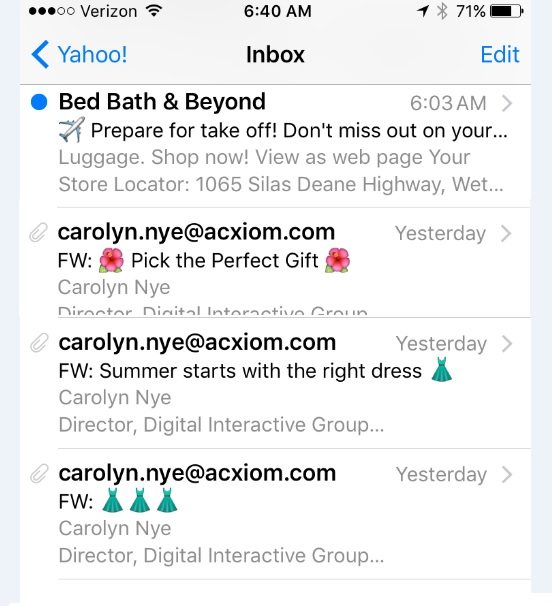Email subject lines are key to capturing a reader’s attention and standing out from inbox clutter. But email preheaders may be just as important, since most recipients now open emails on smartphones.
An email preheader is the text that typically appears above the creative copy and, on most smartphones, directly beneath the subject line. Note the screen capture below from a smartphone that shows email subject lines, “from” lines, and preheaders.

As viewed on many smartphones, the email preheader text is nearly as prominent as the subject line.
When opened on a smartphone, the email preheader below — “Treat your smile to a $29 exam…” — remains at the top of the creative copy.

Preheaders — such as this example: “Treat your smile to a $29 exam…” — remain above the creative copy after emails are opened.
Prior to the rise of mobile devices, email marketers tended to use preheaders for two reasons:
- To ask recipients to click to download images so the full email can be viewed;
- To ask recipients to add the sending domain to their contacts so future emails will be received in the primary inbox.
However, in today’s mobile-centric world, the need for these two statements is not as important. Moreover, it wastes valuable real estate. The preheader text on a smartphone is almost as large as the subject line. Preheaders should be used as extensions of subject lines to entice recipients to open or to supply additional information that cannot fit in the subject line.
Using Emojis in Subject Lines
Emojis are becoming increasingly popular in subject lines. Here are the pros and cons for using them, in my experience.
Pros
- Visually convey a message that is difficult with words.
- Use fewer words in the subject line.
- Stand out from competition in the inbox.
Cons
- Browsers and email clients render emojis differently.
- Possible negative impact on a sender’s overall brand.
Many consumers consider emojis to be cute and fun. Using emojis in subject lines should therefore be a branding decision. They typically work well for younger, hipper brands. But they may not be the right choice for other companies, such as those in finance or healthcare, that want to convey a more serious impression. However, most retailers can use emojis to good effect.
Emojis will render differently depending on the browser or email client. Mobile browsers will typically show emojis in full color. But desktop clients, such as Outlook, will display black and white versions. Note the example, below, of a subject line in Outlook on a desktop and, separately, on an iPhone. While both render well, the mobile version is more effective.

Emojis appear in gray scale in Outlook on a desktop. On iPhones, they are in color.
Here are other examples of emojis in subject lines on Outlook (desktop) and on an iPhone.

Emojis on Microsoft Outlook for desktop computers render well, but they appear in black and white, making them less impactful.
—

Emojis on an iPhone stand out more, as the are in color.
If most of your recipients are opening on smartphones, the use of emojis could increase open and click rates. As with any new email tactic, however, testing is crucial. Try an A/B split, comparing a subject line with emojis versus one without. See if there is a difference in opens, clicks, and conversions.
Regardless, use emojis sparingly. While they may be effective initially, once recipients become used to seeing them, they will likely lose their appeal. Use them in about one out of every four emails, to start.





